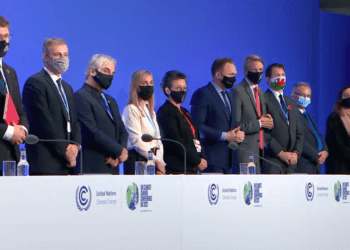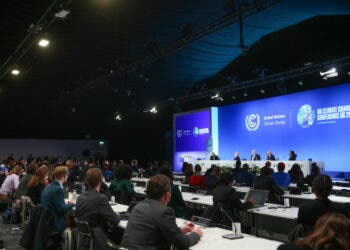Governments, civil society, and media representatives will meet in Glasgow, Scotland during the next two weeks to discuss ways to increase climate action. With the global average temperature already up 1ºC compared to pre-industrial time, there’s no time to lose to cut greenhouse gas emissions (GEI) and avoid the worst effects of the climate crisis. But will this actually make a difference?

The international summit COP26 is the 26th iteration of the Conference of the Parties to the UN Framework Convention on Climate Change (UNFCCC). For almost three decades, governments have met almost every year to take action on climate change, with moments of high drama and also of success — as in the case of the Paris Agreement.
Upgrading our climate plans
In 2015 in Paris, countries agreed to limit the global temperature rise to 2ºC by the end of the century, making every effort to avoid 1.5ºC. This led to the creation of national action plans, known as NDCs, to reduce emissions in every country.
Nevertheless, with the current NDCs, global warming would only be limited to 2.7ºC, according to UN estimations. So even if countries are keeping their part of the deal (which many are not doing at the moment), we’re still on a healthy climate path.
That’s why raising the bar will be one of the main targets at this year’s COP. Under the Paris Agreement, countries have to improve their plants every five years — and that time is now. There’s already been some progress. More than 100 countries have already upgraded their plans ahead of COP, with more ambitious commitments in most cases.
Still, not everybody is fully committed. China, the main polluter accounting for 27% of all the world’s emissions, just updated its NDC but maintained a previously announced target to peak emissions before 2030. Meanwhile, Saudi Arabia pledged to reach net-zero by 2060 but without changing its role as the world’s leading oil producer, raising questions on the substance of its plan.
A report by the Intergovernmental Panel on Climate Change (IPCC), a leading group of climate experts, from August found that the world still has a chance to stay within the 1.5ºC threshold. But that would require concerted efforts to stop emitting carbon dioxide and other dangerous greenhouse gases almost completely by mid-century.
Getting a 1.5ºC increase will still lead to extreme weather events such as heatwaves, floods, and heavy storms, as well as rising sea levels and bleaching of corals. But these consequences would be far less severe than the ones associated with a rise of 2ºC. That’s why it’s so important for countries to present their plans as soon as possible.
Not just NDCs
While improving climate commitments will be a central part of the talks in Glasgow, the UK, acting as the COP26 president, is also focusing on three other areas: climate finance, phasing out coal, and nature-based solutions. This is because the COP president is entitled to choose the priority issues that countries should focus on.
Climate finance essentially refers to the money that is provided to underdeveloped countries from public and private sources to help them reduce their emissions and cope with the impacts of extreme weather. This is more than just humanitarian help — it’s a way for developed countries to amend their past emissions. After all, developed countries became developed by burning fossil fuels, so they have a greater responsibility in this crisis.
At COP15 in Copenhagen, underdeveloped countries were promised that they would get $100 billion every year, starting in 2020. But the target has not yet been reached. A report by the Organization for Economic Cooperation and Development (OECD) in September found that about $80 billion was offered last year, instead of the agreed $100 billion. This symbolic number won’t be reached until 2023, according to a UK-commissioned report. Even when it is reached, it’s doubtful that it will be sufficient. About 150 environmental groups wrote a letter to donor countries earlier this month asking them to mobilize $600 billion between 2020 and 2025, which would be more realistic to their needs. In fact, a report by the UN Climate Change committee on finance says that developing countries will need about $5.9 trillion up to 2030.
No more coal
Coal, or rather, the phase-out of coal, is also expected to be a big theme at COP. Governments know they have to transition to other cleaner energy sources, and some have already taken steps in this direction. China, the main coal consumer in the world, announced earlier this year that it will stop financing new coal-fired plants in other countries. But there’s a lot more that needs to be done.
India, Indonesia, Australia, and many other countries are still large producers and consumers of coal. It’s a big energy source, supplying one-third of the global energy. But its demand is declining, as countries realize it’s not a good bet both on economic and environmental terms.
The UK COP hosts also want to see progress in nature-based solutions. These are projects such as preserving and restoring forests and other carbon sinks and growing more trees. There are already big initiatives in place, such as planting one billion trees. Still, experts argue this won’t solve the climate crisis alone and that our reliance on fossil fuels also has to end.
The tricky carbon markets
While the Paris Agreement was signed in 2015, not every aspect was fully finalized because of the many disagreements between countries. The trickiest one has been by far the creation of a new global carbon market. Under Paris, countries have to set up a carbon trading system to help decarbonize the economy known as Article 6.
This market would allow countries to finance projects that reduce emissions in other countries and count the avoided emissions towards their own climate targets. But without transparent and robust accounting rules, it has the potential to undermine the goal of keeping 1.5ºC between reach — a concern expressed by several countries.
The UK hopes to resolve this issue in Glasgow so countries can have this mechanism in place to better deliver on their climate targets. China already set up its own national market and is pushing for a global one. But it’s a challenging task. In the last climate summit, countries couldn’t agree on this after two days of overtime and nine drafts.
This year’s COP will probably be the most significant one since Paris, especially because of its one-year delay due to the pandemic. The climate crisis is here and affecting us all. But whether we allow it to continue and worsen will depend on the actions taken today by governments, both from developed and developing countries.






